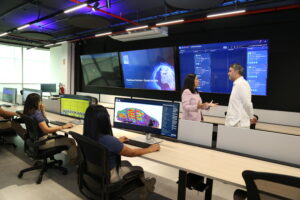Thanks to the Export Control and Related Border Security Program (EXBS), whose objective is to support port and customs control of partner nations, the U.S. Department of State and the U.S. Embassy in Panama donated four Rapiscan Eagle M60 mobile container scanners to the Panamanian National Customs Authority (ANA). U.S. Ambassador to Panama Mari Carmen Aponte made the donation on behalf of the United States.
This effort is a result of the close collaboration and partnership between EXBS and Nonproliferation and Disarmament Fund which provided funding for the donation, valued at $15 million, including state-of-the-art scanners, software, and the remodeling and equipping of the Image Analysis Center, part of ANA’s Monitoring, Control, and Video Surveillance Center.
In 2022,The United States delivered to Panamanian authorities seven of these machines, three of which were purchased by the Panamanian Government with funds confiscated by the United States and then transferred to Panama under the U.S. forfeiture law. The resources were related to the Speed Joyeros money laundering case, which involved several jewelry stores and artisans in that nation.

With this donation the U.S. government reaffirms its support to the efforts of Panama’s Invisible Shield program, with non-intrusive technology to optimize through a network of scanners installed at strategic points, the monitoring and surveillance of containers entering and circulating in the country, a U.S. Embassy spokesman said in a statement.
Panama’s Customs Director General Tayra Ivonne Barsallo told Diálogo on September 12 that the scanners were installed at several of Panama’s main land control points, such as Guabito, Paso Canoas, and at the entrance and exit of the Colón Free Zone.
“The analysis of the images will enhance the capacity to review the customs control load generated by all customs destinations, regimes, and formalities,” Barsallo said. “It is also a powerful weapon in the fight against organized crime from the main customs control points.”
The new scanners produce high-definition 3D images of container cargo, which streamlines the process of reviewing goods through mobile and easy-to-use inspection equipment, speeding up the verification of manifests, and ensuring the detection of threats and contraband objects.
According to the official, with this equipment it is possible to monitor, analyze, and evaluate the data issued by the non-intrusive inspection equipment, so that this sensitive information can be shared with all national security agencies, allowing authorities to implement, in a coordinated and expeditious manner throughout the national territory, measures to prevent various terrorist threats, smuggling, tax fraud, or money laundering.
Both the scanners and the artificial intelligence used provide valuable cargo information, thus avoiding the need to empty containers for manual screening. The equipment is designed to identify the presence of explosives, ammunition, drugs, tobacco, or concealed persons. In addition, these modern machines have the ability to identify the presence of radioactive isotopes and are capable of distinguishing between organic and inorganic material, which is crucial for narcotics detections and seizures.
Currently, ANA has 102 officials trained to use these scanners and to perform analysis at the Image Analysis Center.









